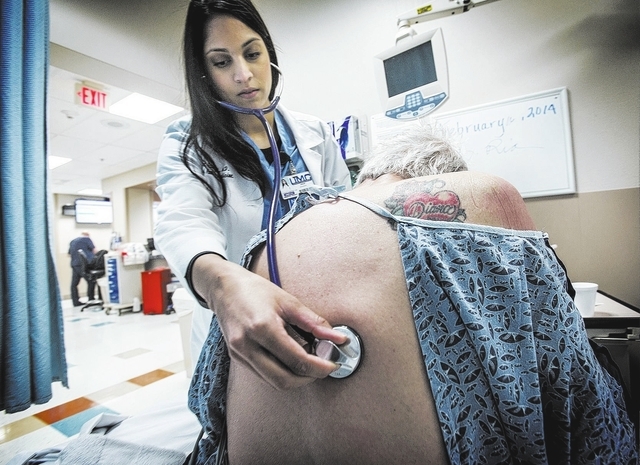Knowing when to head straight to ER could save a life
It’s the weekend, and you find yourself in need of medical attention. It could be a swollen ankle, fever or an allergic reaction. Should you head to the emergency room or an urgent care center?
In order to receive the proper care and potentially save a life, people must understand the difference between the ER and urgent care centers.
“Every situation is different, and every pain is different,” said Edwin “Flip” Homansky, chief quality officer of the Valley Health System. “Most people have enough common sense to know where to go, but when in doubt, the emergency room is the safest place to go. If it’s time-sensitive, it’s best to call 911.”
There are roughly 80 urgent care centers in the Las Vegas Valley, with more than half open seven days a week, all of which see adult and child patients, according to urgentcarelocations.com, a directory of urgent care centers.
Yet with the rise of urgent care centers, Dr. Michael Gerardi, president of the American College of Emergency Physicians, cautioned in a recent editorial in various national papers that many patients are putting their health at risk by visiting the wrong care facility.
“Some emergency conditions are more obvious than others. Most people would not hesitate to go to the ER for a gunshot wound, for instance,” he wrote. “But something like slurred speech also requires a trip to the emergency room. It’s a symptom of stroke, which can kill two million brain cells a minute. Delaying treatment by minutes can be the difference between recovery and death.”
Urgent care centers can provide treatment for the flu, colds, fevers, headaches, sprains and chills. Centers also provide immunizations, such as flu shots, and often have after-hours care.
ERs, on the other hand, are intended to help patients who have health concerns that require immediate attention. The sickest patients in an ER generally go to the head of the line.
Some reasons to seek emergency care include: loss of consciousness, severe shortness of breath, facial drooping or weakness in an arm or leg, allergic reactions, chest pain, bleeding that does not stop after 10 minutes, head trauma, seizures, poisoning, severe reaction to insect bites, major broken bones, coughing or vomiting blood, persistent vomiting and suicidal or homicidal feelings, according to a list compiled by the American College of Emergency Physicians.
Although an ER could treat people with urgent care issues, emergency rooms are often busier and more expensive because they are available 24/7.
The average cost of an urgent care visit can range from $71 to $125 for basic care, with additional costs added for shots, X-rays, and lab tests. The average emergency room visit costs $1,318, according to urgentcarelocations.com.
The difference between wait times also fluctuates. The ER has an average wait time of 2.4 hours, whereas urgent care centers are able to see walk-in patients within 15 to 45 minutes, according to the website.
It is important to note that urgent care centers are often open on weekends and evenings, in addition to normal business hours, and most don’t require appointments. Patients are served on a first-come, first-served basis.
Many urgent care centers offer X-rays, just like ERs. But only some centers are equipped with MRIs, CAT scans and in-house laboratories.
“People need to look at their patterns to see what type of care they need,” said Dr. Dale Carrison, chief of staff and head of emergency services at University Medical Center. “It also depends on their age and past medical history. If you have the flu, for example, you don’t need to go to the emergency room unless you’re under 2 or over 65. Age is a big factor.”
Urgent care centers and ERs are able to give patients shots, medications, IVs and even treatment plans.
Neither ERs nor urgent care centers are equipped to deal with nonemergency, chronic conditions. Patients with chronic needs such as depression or diabetes need to be seen by a primary care physician.
“Think of it this way: If people need to see their primary care physicians, but the soonest appointment is two or three months away, then going to an urgent care center is the next best thing,” Carrison said. “But urgent care centers are not an alternative for emergency rooms.”
Contact North View reporter Sandy Lopez at slopez@viewnews.com or 702-383-4686. Find her on Twitter: @JournalismSandy.
Retail health clinics are offered at many major pharmacies and retail stores, which have walk-in clinics staffed by medical professionals. It’s best to go there when you need convenient, routine care, such as for coughs and flu shots.
No appointments are needed to do a walk-in at the doctor’s office, and people usually aren’t required to be an existing patient. This alternative is best to use when you need simple medical care in a hurry, such as for mild asthma or minor allergic reactions.
If you’re concerned about a possible poisoning or exposure to a toxic substance, call Poison Control at 800-222-1222.




























